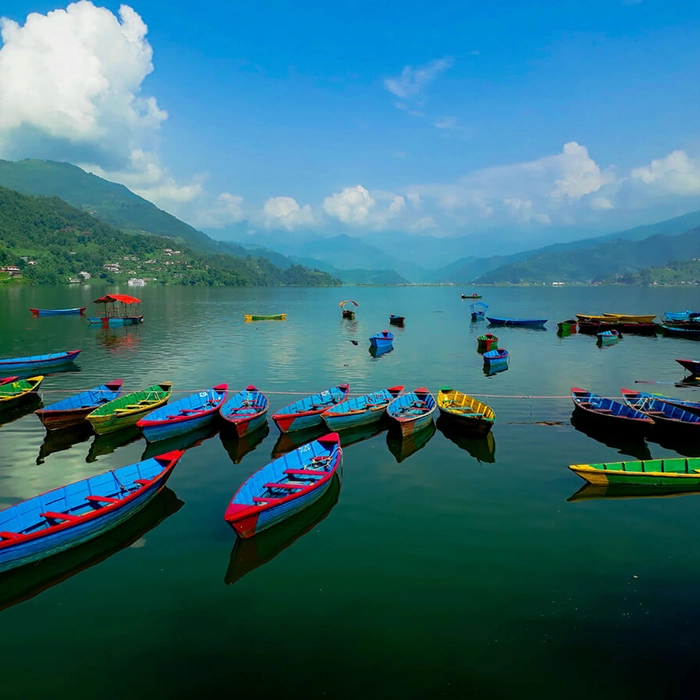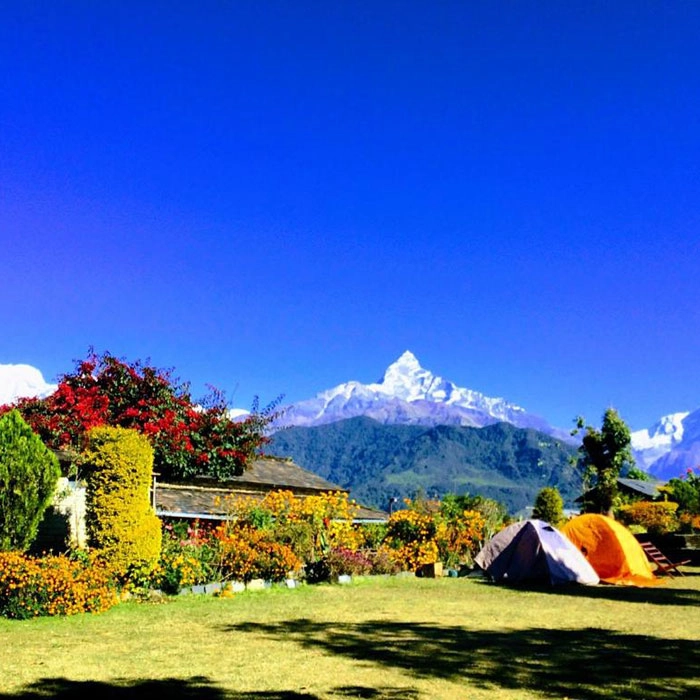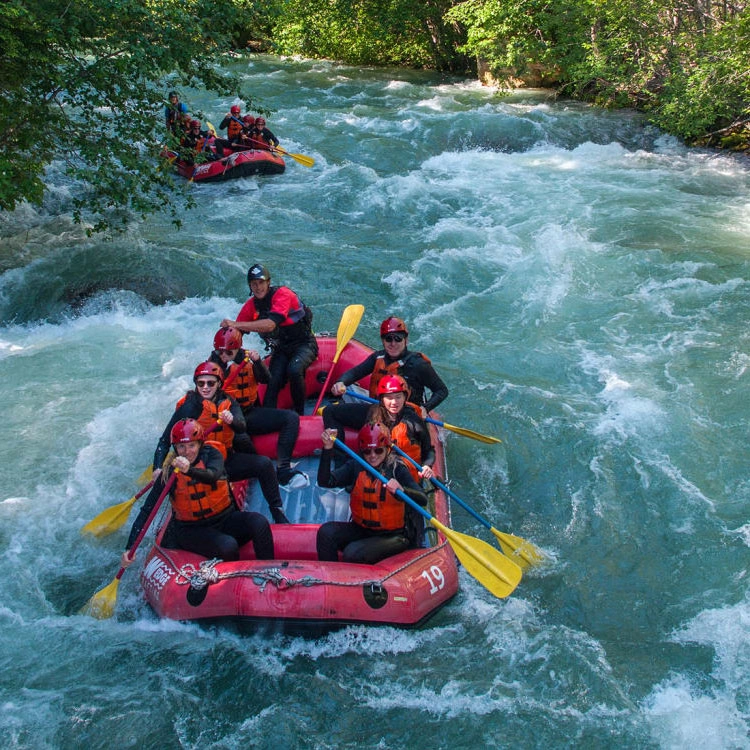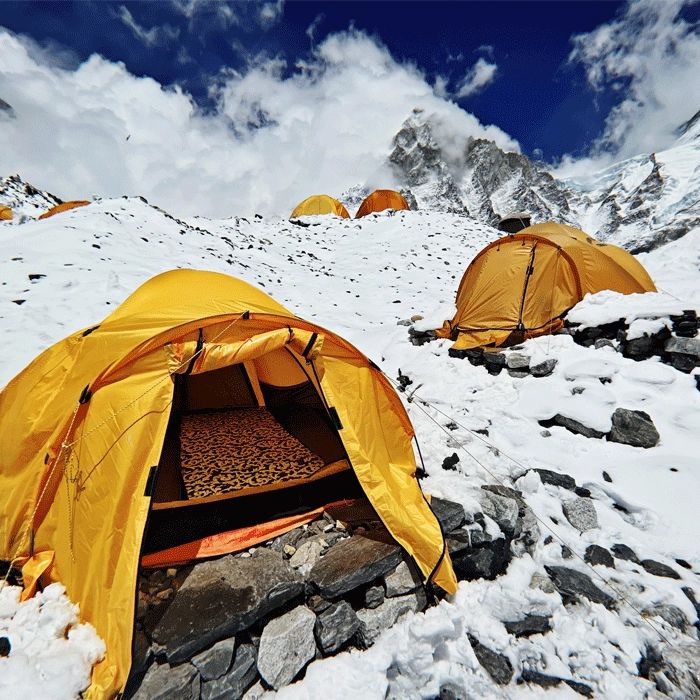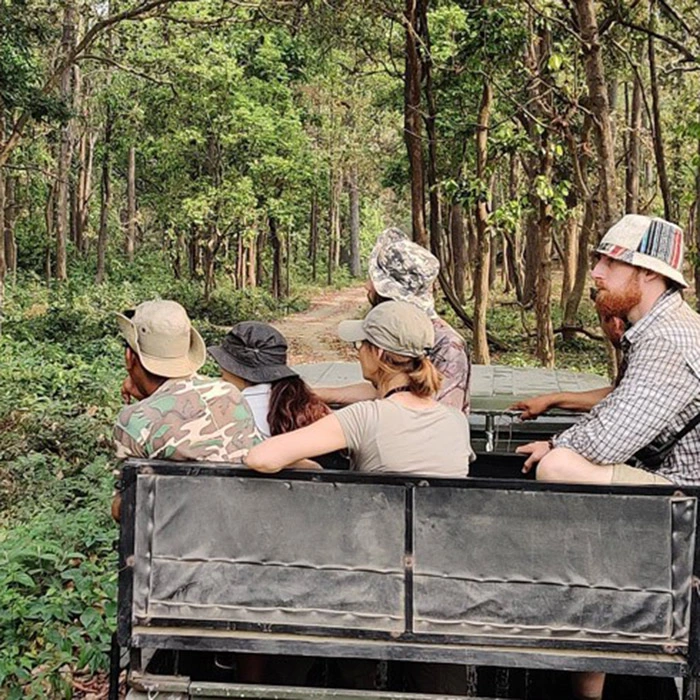INNER DOLPO TREK
US$0.00
/pp
-
23 Days
-
Upper Dolpo
-
Spring/Autumn
-
Trekking
-
5,360 Meters
-
Hard
-
Car / Plane
-
02-16 People
-
JH#298
 Overviews
Overviews
Embark on the Inner Dolpo Trek, an extraordinary journey through Nepal’s remote wilderness, revealing untouched landscapes and rich culture. This trek reveals untouched landscapes and rich culture in one of Nepal’s most isolated regions, where ancient Tibetan traditions and stunning natural beauty come together. The trek begins with the challenging ascent of Jyanta La Pass (5,220 m / 17,126 ft). Next, you cross Sela La Pass (5,095 m / 16,716 ft), and finally, Kang La Pass (5,350 m / 17,552 ft), also known as Nagdalo La. Each pass presents its own challenges but rewards you with breathtaking views of the rugged Dolpo terrain and the towering Dhaulagiri peaks. In Saldang, the largest village in Upper Dolpo, you will discover the distinguished Saldang Monastery. This monastery, perched high on a barren mountainside, is a cultural and spiritual hub. Its ancient murals and sacred artifacts provide a glimpse into the traditional Tibetan lifestyle preserved for centuries. Another highlight is Shey Gompa, an ancient monastery located in a remote valley. This revered site acts as a hub for Buddhist scholarship and profound spiritual reflection. Surrounded by rugged mountains and high-altitude landscapes, Shey Gompa offers a unique chance to connect with the Bon and Buddhist traditions. Near the trek’s heart, you’ll find Ringmo Monastery close to Shey Phoksundo Lake (3,640 m / 11,942 ft.). This monastery is known for its vibrant community and picturesque setting, with the lake’s turquoise waters providing a stunning backdrop. The lake is a jewel of the Dolpo region, celebrated for its pristine beauty and tranquility. The Inner Dolpo Trek is more than a physical challenge. It’s an exploration of a land where time seems to stand still. From the spiritual sanctuaries of Shey Gompa and Saldang Monastery to the stunning mountain vistas and serene lakes, this trek offers a profound connection to the untouched wilderness and ancient culture of Dolpo. It promises to be an unforgettable adventure for any trekker.
 Itinerary (Plan)
Itinerary (Plan)
Arrive in Kathmandu (1,400 m / 4,593 feet), Nepal's vibrant capital, where you'll be warmly welcomed with marigold garlands. After transferring to your hotel, take time to relax and acclimate to the bustling city. Discover vibrant local markets, indulge in traditional Nepali dishes, and delve into Kathmandu's rich cultural tapestry. This initial day is perfect for easing into your journey, setting the stage for the exciting adventures ahead in Eastern Nepal. A representative from Jagadamba Holidays will ensure a smooth and pleasant arrival.
Optional Evening Activity:
If you wish, you can spend your evening experiencing the Pashupatinath Aarti, a captivating religious ceremony held at the Pashupatinath Temple. The Aarti usually begins around 6:00 PM and lasts for approximately an hour. This ceremony is a mesmerizing display of traditional music and rituals, providing a profound insight into Hindu spiritual practices. Please check the exact time for the Aarti on the day of your visit, as it may vary. This option is not included in the standard itinerary but offers a unique opportunity to immerse yourself in local culture.
Begin your day with a guided exploration of Kathmandu’s rich cultural and heritage sites, immersing yourself in the city’s history and spiritual traditions. Visit Pashupatinath Temple, a sacred Hindu site along the Bagmati River, where daily rituals and ceremonies offer a glimpse into Nepalese devotion. Continue to Boudhanath Stupa, one of the largest Buddhist stupas in the world, surrounded by monasteries, prayer wheels, and vibrant Tibetan culture, creating a serene and inspiring atmosphere. In the afternoon, explore the architectural treasures of Patan Durbar Square, a UNESCO World Heritage Site renowned for its Malla-era temples, courtyards, and intricate stone and wood carvings. Highlights include the Krishna Mandir, the Golden Temple, and the terracotta-adorned Mahabouddha Temple. This immersive cultural tour provides a deep understanding of Kathmandu’s artistic and religious heritage. The day concludes with trek preparation and pre-trip briefing at your hotel, organized by the Jagadamba Holidays team. All Dolpo trekking permits and documentation are arranged, and your guide will review the route, safety instructions, equipment tips, and answer any questions. This ensures you are fully prepared and confident before embarking on your high-altitude Dolpo adventure.
After a hearty breakfast at your hotel, Kathmandu Guest House in Thamel, Kathmandu (1,400 m / 4,593 ft), proceed to the domestic airport for your scenic 1-hour flight to Nepalgunj (150 m / 492 ft). As the plane ascends, enjoy stunning aerial views of the Kathmandu Valley, rolling hills, and terraced farmland. On clear days, you may spot snow-capped Himalayan peaks including Langtang, Ganesh Himal, Manaslu, and the majestic Dhaulagiri range, along with the distant Dolpo region mountains, offering an early glimpse of the high-altitude adventure ahead. Upon arrival in Nepalgunj, a vibrant town on the edge of Nepal’s Terai plains, take in its lively markets, bustling streets, and multicultural atmosphere. Known as a gateway to western Nepal, Nepalgunj reflects a blend of Tharu, Nepali, and Muslim cultures, with colorful bazaars and local eateries that provide a taste of the region’s unique lifestyle. Use this leisure time to explore, shop, or sample local delicacies, making it a perfect introduction to the Terai before your trek. In the evening, return to your accommodation for rest and pre-trek preparation. The Jagadamba Holidays team will assist with all trekking permits and arrangements, while your guide provides a pre-trek briefing, ensuring you are fully prepared, informed, and energized for the journey ahead.
After a hearty breakfast at Batika Hotel in Nepalgunj (150 m / 492 ft), proceed to the domestic airport. Begin your journey with a 35-minute flight from Nepalgunj to Juphal Airport (2,475 m / 8,124 ft). The flight provides panoramic aerial views of the Terai plains, mid-hills, and distant Himalayan ranges, including peaks of the Dolpo region. This short flight smoothly transitions you from lowland subtropical terrain to highland landscapes, offering an early orientation of the region’s topography. Upon landing at Juphal, commence the trek to Dunai (2,140 m / 7,020 ft). The route is moderate in difficulty, with gradual ascents and descents along well-marked trails. Hikers should be cautious of rocky sections and minor river crossings. This trek is ideal for acclimatization, allowing travelers to adapt to altitude while observing the local flora, fauna, and settlement patterns. The trek spans approximately 12 km and requires 5–6 hours of walking. During the journey, participants will ascend 180 meters and descend 660 meters, passing through traditional villages, terraced farmland, and forested areas. Cultural and architectural highlights include stone-built houses, prayer flags, and small gompas, reflecting the Tibetan-influenced heritage of the Dolpo region. By the end of the day, you will arrive in Dunai, a key administrative and cultural hub. Travelers can rest, enjoy local hospitality, and prepare for the following days of trekking, having gained their first immersive experience of Dolpo’s stunning landscapes, traditional communities, and high-altitude environment.
After a hearty breakfast at lodge in Dunai, we began our trek to Tarakot at 2,540 m (8,333 ft). The route follows the Thuli Bheri River valley through terraced fields, lush forests, and traditional Dolpo villages. Along the way, we crossed hanging bridges and passed through dramatic gorges, showcasing the raw beauty of Lower Dolpo. As the valley widened, the scenery transformed from fertile farmland into rugged landscapes dotted with mud-brick houses, blending natural charm with cultural richness. Today’s trek covers 17 km and generally takes 6 to 7 hours. During the journey, we ascend approximately 730 metres and descend around 110 metres. The trail follows the riverbanks, crossing the Thuli Bheri River several times before gently climbing a small hill near Tarakot. This stage provides a smooth introduction to trekking in the Dolpo region, combining gradual elevation gain with opportunities to acclimatize to the Himalayan environment. By late afternoon, we reached Tarakot, a historic settlement known for its distinctive architecture, ancient heritage, and traditional lifestyle. As accommodations are limited, we stayed in tented camps, where the support team set up tents and the kitchen staff prepared freshly cooked meals. After a warm dinner under the starry Himalayan sky, we rested and embraced the tranquil atmosphere of the Dolpo wilderness.
After a hearty breakfast at camp in Tarakot, we began our trek to Laina Odar (3,370 m / 11,056 ft) along the winding trails of the Thuli Bheri River. The route meanders through the vibrant fields of the Tichurong Valley, crossing small streams and suspension bridges that connect picturesque villages. We passed through pine and fir forests, terraced farmland, and dramatic gorges that highlight the rugged beauty of the Lower Dolpo region. The journey included a crossing over the Yalankot River, a gradual ascent through shaded forests, and a descent to a checkpoint at the confluence of the Bharbung Khola and Tarap Khola. Following the Tarap Khola northward, the trail led us into the magnificent Tarap Gorge, where steep cliffs and the soothing sound of rushing waters added to the day’s adventure. Today’s trek covers a distance of around 14 km and generally takes 6 to 7 hours of steady walking. Along the way, we ascended approximately 1,040 m and descended about 430 m, making this a moderate but highly rewarding section of the Dolpo trekking route. The path alternated between riverside trails, forested ridges, and terraced slopes. The presence of the ancient Chhedhul Gumba along the route offered cultural insight and moments of rest, while the undulating terrain provided excellent acclimatization. The mix of cultivated valleys, alpine vegetation, and dramatic gorge landscapes made this one of the most diverse days of the Dolpo trek. By late afternoon, we reached Laina Odar, also known as Lahini Odar, a tranquil resting place nestled against rocky cliffs and river valleys. This remote stop offers no lodges, so accommodation is arranged in tented camps, where your support team sets up tents and the kitchen staff prepares warm meals. Surrounded by forests and the constant murmur of the river, the campsite offers a peaceful atmosphere to unwind and recover. Dinner under the Himalayan night sky completed the day, leaving us with both cultural memories and deep connections to the untouched beauty of Dolpo.
After a hearty breakfast at camp in Laina Odar, we began our trek to Nawarpani (also known as Pibuk) at 3,475 m / 11,401 ft. The trail follows the wild and beautiful Tarap Khola Gorge, one of the most dramatic landscapes in Lower Dolpo. The path climbed steeply along the rocky cliffside ledges, with sections carved directly into vertical rock walls, offering thrilling views of the turquoise waters far below. The journey meandered through pine and juniper forests, streams flowing into the Tarap River, and narrow canyons where the roar of the river echoed between towering cliffs. Each turn revealed pristine wilderness and occasional traces of ancient Dolpo settlements, highlighting the blend of raw nature and cultural heritage. Today’s trek covered a distance of 15 km, requiring around 6 to 7 hours of steady walking. Along the way, we ascended 960 m and descended 490 m, making this a moderately challenging but highly rewarding stage of the Dolpo trek. The steep climb to Laina Top tested stamina but rewarded us with sweeping views across the gorge. From there, the undulating trail followed the river northward, alternating between high ridges and riverside tracks. Passing by the historic Chhedhul Gumba, trekkers experienced moments of reflection and cultural depth, while the rugged gorge and rushing river created a constant sense of adventure. By late afternoon, we reached Nawarpani (Pibuk), a remote settlement beside the Tarap Khola. Known for its cave-style kitchens and seasonal shelters, it reflects the resilience of people living in the Dolpo highlands. With no permanent lodges available, our team set up tented camps by the river, where freshly cooked meals were prepared by the kitchen staff. The peaceful riverside atmosphere, framed by dramatic cliffs and the sound of flowing water, created an unforgettable camping experience. After dinner under the star-studded Himalayan sky, we embraced the tranquility of Dolpo’s wilderness and prepared for the adventures ahead.
After a hearty breakfast at camp in Nawarpani, we began our trek to Dho Tarap (3,944 m / 12,940 ft), one of the highest inhabited villages in the Himalayas. The trail followed the Tarap Khola through a narrow gorge, where steep cliffs towered above the river. We crossed suspension bridges several times, alternating between wooded paths and rocky ledges. At Kamattarka, the confluence of the Tarap Chu and a stream from the east, the gorge gradually opened into alpine meadows. Fragrant juniper and wild rose bushes marked our passage above the tree line, while the wider valley revealed the raw and untouched beauty of Dolpo. Today’s journey covered 16 km and took 7 to 8 hours of walking. We ascended 470 m and descended 170 m, making this stage a steady but manageable climb. The route combined riverside sections, forested ridges, and high meadows, with a lunch stop at Langa, a scenic spot overlooking the valley. The gradual elevation gain allowed for acclimatization while providing varied landscapes, from cultivated fields to windswept highlands, ideal for a smooth transition into the upper reaches of the region. By late afternoon, we reached Dho Tarap, a traditional settlement surrounded by irregular stone walls and lined with mud-brick houses. The village is rich in Tibetan culture, where both Nyingma Buddhism and the ancient Bon religion are still practiced. Prayer flags fluttered above monasteries, adding a spiritual charm to the remote setting. With no lodges available, we stayed in tented camps, where the support team prepared dinner. The peaceful evening in Dho Tarap, filled with cultural encounters and the sound of the highland winds, offered both rest and a memorable glimpse into the heart of Dolpo.
After a hearty breakfast at camp in Dho Tarap (4,080 m / 13,386 ft.), begin your day exploring one of the highest permanently inhabited valleys in the world. This remote settlement is home to a unique blend of Bon Po and Buddhist traditions, offering a rare cultural experience in the heart of Upper Dolpo. Visit centuries-old monasteries such as Ribo Bhumpa and Drakmar Dewa, where intricate murals, sacred relics, and glowing butter lamps reveal the deep spiritual heritage of the region. As you stroll through the valley, admire traditional stone houses with flat roofs, cultivated barley fields, and warm-hearted locals who may invite you for a cup of butter tea—a genuine glimpse into the resilient Dolpo lifestyle. Later in the day, embark on the scenic trek from Dho Tarap to Tokyu. The trail follows the gentle flow of the Tarap Khola, meandering through a broad high-altitude valley framed by rugged, mineral-streaked mountains. The landscape is vast and unspoiled, painted in earthy hues beneath an immense Himalayan sky. With every step, the silence of the valley surrounds you, broken only by the whistle of the wind or the distant call of a marmot. This tranquil stretch allows time for reflection as you experience the raw beauty of Upper Dolpo’s wilderness. The trek from Dho Tarap to Tokyu covers a distance of 5 km and usually takes 2–3 hours of gentle walking. Along the way, you gain a gradual ascent of 110 meters and descend just 10 meters, making it a comfortable and enjoyable section of the journey. The route blends riverside paths, cultivated fields, and windswept meadows, offering constant variety in the scenery. The wide valley floor provides expansive views of the surrounding mountains, while the steady pace and modest elevation gain support proper acclimatization. As you continue along this scenic stretch, you notice the transition from fertile farmland to more barren highlands, symbolizing the shift deeper into the heart of Dolpo’s dramatic landscapes. By late afternoon, you reach Tokyu (4,209 m / 13,809 ft.), a small settlement surrounded by towering Himalayan peaks and traditional homesteads. After settling into your teahouse, enjoy a hearty evening meal and reflect on the cultural encounters of Dho Tarap and the peaceful beauty of the trek. This overnight stay strikes a perfect balance between authentic cultural immersion and the pristine landscapes of Upper Dolpo, preparing you for the journey ahead.
After a hearty breakfast at camp in Tokyu (4,209 m / 13,809 ft.), begin your journey deeper into the high wilderness of Upper Dolpo. Leaving behind the last permanent settlements, you step into an untouched landscape where human presence is rare and nature dominates. The trail follows the turquoise flow of the Tarap Chu River, leading you away from cultivated fields and stone-built homes into the stark, majestic canyon country of Dolpo. Towering cliffs rise in bands of ochre, grey, and red rock, while small patches of alpine grass cling to the slopes. This section offers a raw and humbling glimpse of the region’s geology and timeless beauty, with the ever-present sound of the river echoing below. Along the way, you may spot elusive wildlife such as blue sheep (bharal) grazing on the ridges or a soaring lammergeier (bearded vulture) circling high above. From here, you begin the scenic trek from Tokyu to Jyanta La Phedi (Murjun), gradually climbing higher into the remote canyons and open valleys of Dolpo. As the trail ascends, the canyon narrows before opening into sweeping high-altitude amphitheaters, where the immense Himalayan sky feels endless. The route follows an ancient trade and migration path, once used by yak caravans and nomadic herders, adding a sense of timeless history to the wild surroundings. The region becomes increasingly barren, signaling the approach toward the high Himalayan passes that define this trek. It is important to note that Jyanta La Pass remains open only from April to November, when weather conditions make the crossing safe. The trek from Tokyu to Jyanta La Phedi covers a distance of 8.5 km and takes around 5–6 hours of steady walking. The day involves an ascent of 710 meters and a short descent of 10 meters, making it a demanding but rewarding stage of the journey. The trail blends narrow canyon paths, riverside stretches, and windswept meadows, gradually revealing the towering wall of the Jyanta La Pass ahead. The thinning air, cooler temperatures, and stark terrain all highlight the transition into the upper reaches of the Dolpo circuit. By late afternoon, you arrive at Jyanta La Phedi (4,965 m / 16,289 ft.), also known locally as Murjun, a remote campsite nestled at the foot of the pass. There are no villages here, only rugged highland terrain and perhaps a shepherd’s hut. As the sun dips behind the ridges, the temperature drops sharply, but the atmosphere is unforgettable. A warm dinner in the dining tent offers comfort before the night sky reveals countless stars above. The profound silence of this Himalayan wilderness makes this night a moment of quiet preparation, setting the stage for tomorrow’s challenging ascent over Jyanta La Pass, one of Upper Dolpo’s most demanding yet rewarding high crossings.
After an early breakfast at camp in Murjun (Jyanta La Phedi, 4,965 m / 16,289 ft.), begin your trek from Murjun over the iconic Jyanta La Pass (5,220 m / 17,126 ft.) to the tranquil river confluence at Darsumana Dobhan (4,300 m / 14,108 ft.). This stage represents the pinnacle of the Upper Dolpo trekking circuit, combining high-altitude challenge with unparalleled Himalayan vistas. From the stark, rocky slopes of Murjun, you ascend toward the summit, then descend into a lush valley where two rivers meet, offering both physical reward and visual splendor. The trek covers a distance of 13 km and takes approximately 7–8 hours of steady walking. Along the route, you gain a total ascent of 210 meters to reach the summit and descend 820 meters into the valley below. The trail begins on steep, rocky moraines and narrow zig-zag paths, crosses snow patches near the pass, and transitions into high-altitude meadows and riverbanks adorned with alpine flora. This combination of ascent, descent, and varied terrain provides a challenging but highly rewarding day, allowing trekkers to experience the raw beauty of Upper Dolpo while maintaining safe acclimatization. The day begins in the pre-dawn cold of Murjun, with only the light of your headlamp illuminating the trail. Leaving the last signs of human settlement behind, you climb steadily, following the path of generations of nomadic herders and yak caravans. As the sun rises, the final approach to the summit of Jyanta La Pass comes into view. At the top, you are greeted by a breathtaking 360-degree panorama of the Dolpo range, where prayer flags flutter in the wind and jagged peaks stretch across the horizon. The summit is both a geographical and spiritual highlight, offering a moment to pause, reflect, and appreciate the achievement of standing on the “roof of Dolpo.” The descent into Darsumana Dobhan leads you into a gentler landscape, where flowing streams and patches of greenery appear along the valley floor. The convergence of two rivers gives this campsite its name—Dobhan means “confluence.” Arriving at Darsumana Dobhan, you are rewarded with a sense of accomplishment and the soothing sounds of rushing water. After setting up camp, a warm meal and the pristine Himalayan night sky offer the perfect opportunity to rest and reflect on one of the most memorable and challenging days of the Upper Dolpo trek.
After a hearty breakfast at our camp in Darsumana Dobhan, we embark on the challenging Upper Dolpo trek to Saldang (3,770 m / 12,369 ft), navigating high-altitude, rugged Himalayan terrain. The trail begins with a long, steady descent along the rushing river through a deep, arid canyon, with steep cliffs, narrow ridges, and rocky outcrops demanding careful footing. The stark Dolpo landscapes surround us, with barren valleys, rugged rock formations, and vast open skies creating a breathtaking sense of remote wilderness adventure. The trail provides panoramic Himalayan views at every turn, contrasting arid cliffs with patches of riverine vegetation and seasonal wildflowers. The trek covers 18.5 kilometres and typically takes 7 to 8 hours, with a descent of approximately 630 metres and an ascent of around 310 metres. Along the route, trekkers encounter unique flora and fauna, including Himalayan herbs, snowcocks, and Himalayan foxes. The path alternates between valley floors, rocky ridges, and high-altitude stretches, offering both physical challenge and scenic rewards. We pause for a riverside lunch, soaking in the pristine Himalayan wilderness, capturing photographs, and enjoying the serenity of this remote Dolpo environment. By late afternoon, we arrive at the sprawling village of Saldang (3,770 m). Its traditional mud-brick and stone houses, prayer flags, and chortens reveal the rich Dolpo-pa culture. Trekkers can interact with locals, observe traditional farming practices, and experience life in one of Nepal’s highest and most remote settlements. We check into our pre-arranged tented camp, prepared by the support team, and spend the evening free to explore the village, rest weary legs, enjoy the crisp mountain air, and witness a dramatic Himalayan sunset, followed by a warm dinner under the stars, preparing for the adventures ahead.
After a hearty breakfast at our camp in Saldang (3,770 m / 12,369 ft), we take a final opportunity to explore the village, the largest and most vibrant settlement in Upper Dolpo. We wander through its narrow lanes, past traditional flat-roofed houses and extensive terraced fields, observing the daily rhythms of life in this remote Himalayan community. The morning light illuminates the intricate architecture and prayer flags, offering a perfect chance to photograph the unique cultural atmosphere of this historic trading hub while soaking in the authentic Dolpo-pa lifestyle. Following our exploration, we begin the trek to Namgung (4,360 m / 14,304 ft), ascending steadily into even higher and more remote landscapes. The trail climbs gradually out of the Saldang valley, unveiling breathtaking wide-open vistas of surrounding mountains and stark, high-altitude deserts. Ancient trails wind across the slopes, passing traditional chortens and mani walls, with the chance to spot herds of Himalayan blue sheep grazing in the distance. The raw, untouched beauty of Dolpo is on full display throughout the journey, with dramatic cliffs, rolling hills, and scattered high-altitude hamlets punctuating the route. The trek covers approximately 7.5 km and typically takes 3 to 4 hours, with an ascent of 600 metres and a descent of 160 metres. Trekkers enjoy panoramic views of snow-capped peaks, deep valleys, glacial streams, and sweeping alpine landscapes. The trail is uneven and rocky in sections, requiring careful footing and a steady pace, while the limited facilities underscore the adventurous and exclusive nature of this high-altitude journey. Along the way, trekkers can pause to rest, capture photographs, and take in the serene Himalayan wilderness that surrounds the path. By late afternoon, we arrive at the serene village of Namgung, perched dramatically on a mountainside. The climb is rewarded with a profound sense of peace and stunning panoramic views. Namgung is known for its ancient monastery and traditional way of life, offering a deeply authentic and culturally rich stop. Our tented camp provides a warm welcome, allowing us to rest, reflect, and enjoy the crisp mountain air, concluding a day spent traversing the magnificent, rugged heart of Dolpo.
After a hearty breakfast at our camp in Namgung (4,360 m / 14,305 ft), we take a final opportunity to explore the village before departing. Wandering through its narrow lanes, we pass traditional flat-roofed houses, terraced fields, and ancient chortens, observing the daily rhythms of life in this remote Himalayan settlement. The morning light illuminates the intricate architecture and fluttering prayer flags, offering an ideal moment to photograph the authentic Dolpo-pa culture and absorb the unique atmosphere of one of Upper Dolpo’s most significant villages. After exploration of Namgung, we begin the trek toward Shey Gompa (4,343 m / 14,245 ft), one of the most epic challenges of the Upper Dolpo adventure, including the formidable Sela Pass (5,095 m / 16,715 ft). The trail ascends steadily, climbing approximately 680 metres over rocky, high-altitude terrain. Trekkers navigate exposed ridges, windswept slopes, and thin air, requiring careful pacing and endurance. Reaching the summit of Sela Pass is a monumental achievement, rewarded with breathtaking panoramic views of the rugged Dolpo landscapes and distant Himalayan peaks, making this one of the most memorable sections of the trek. From the summit, the trail descends around 760 metres into the remote valley cradling Shey Gompa. The scenery transforms dramatically, from barren, mineral-rich slopes to eroded cliffs, glacial streams, and high-altitude pastures. Along the way, trekkers can spot Himalayan wildlife, including blue sheep and snowcocks, while panoramic views of snow-capped peaks, deep valleys, and scattered high-altitude hamlets emphasize the raw, untouched beauty of Upper Dolpo. The path is uneven and rocky, requiring steady footing, while the descent tests endurance and heightens the anticipation of reaching the sacred gompa. By late afternoon, we arrive at Shey Gompa (4,343 m / 14,245 ft), perched in a tranquil valley and surrounded by sweeping alpine landscapes. The ancient monastery complex, home to the revered Crystal Mountain, represents the cultural and spiritual heart of Dolpo. Here, trekkers can experience Tibetan Buddhist heritage, enjoy a sense of peace and reflection, and immerse themselves in the serene environment. Our tented camp provides a warm welcome, allowing time to rest, explore the gompa surroundings, and reflect on a day spent crossing one of the most dramatic and challenging high-altitude sections of the Upper Dolpo trek.
After a morning exploration of Shey Gompa (4,343 m / 14,245 ft), immerse yourself in the ancient monasteries, sacred rituals, and Tibetan Buddhist traditions of this spiritual hub. The gompa’s intricate murals, prayer halls, and tranquil surroundings provide a profound cultural experience, allowing trekkers to connect deeply with the heritage of the Dolpo-pa people before continuing their journey. Observing daily monastic life and spiritual practices in this remote Himalayan community enriches the trek with cultural and spiritual context, adding depth to the Upper Dolpo adventure. After exploration of Shey Gompa, we begin the trek toward Nagdalo La Phedi (4,900 m / 16,076 ft), also known as Tsakang, following a high-altitude trail through rugged alpine terrain. The morning ascent passes windswept ridges and rocky slopes, gradually climbing toward the pass and offering stunning panoramic views of surrounding mountains, glaciers, and alpine pastures. Trekkers experience the raw, remote beauty of Upper Dolpo, with dramatic cliffs, deep valleys, and occasional glimpses of local wildlife, enhancing the sense of adventure. This trek journey covers approximately 5.5 km and typically takes 3 to 4 hours to complete, depending on pace and health conditions. Along the route, trekkers ascend 570 metres and descend 10 metres, navigating uneven, rocky sections that demand careful footing and steady pacing. Panoramic views of snow-capped peaks, glacial valleys, and alpine pastures accompany the journey, while the combination of cultural exploration and scenic trekking makes this segment both physically rewarding and spiritually enriching. By late afternoon, we arrive at Nagdalo La Phedi (4,900 m / 16,076 ft), a high-altitude campsite set amidst dramatic mountain vistas and open skies. The serene environment provides an ideal setting for rest, acclimatization, and reflection, preparing trekkers for the continued journey deeper into Upper Dolpo. This segment seamlessly blends high-altitude adventure, breathtaking Dolpo landscapes, and cultural immersion, making it an unforgettable day on the Dolpo Circuit.
After a hearty breakfast at camp in Nagdalo La Phedi, we began our trek toward Phoksundo Khola Camp (3,750 m / 12,303 ft), crossing the formidable Nagdalo La Pass (5,360 m / 17,585 ft), also known locally as Kang La Pass. The early morning ascent is steep and sustained, navigating rugged moraines, exposed ridges, and rocky alpine slopes. Thin air, strong winds, and the high-altitude environment require careful pacing and steady energy management. Reaching the summit is a major achievement, rewarded with panoramic views of the Dhaulagiri massif, surrounding Dolpo peaks, and deep glacial valleys, highlighting the remote and dramatic landscapes of Upper Dolpo. This 9.25-kilometer traverse is one of the most challenging days on the Dolpo Circuit, typically taking 6 to 7 hours to complete. Trekkers face a strenuous ascent of 420 meters to the summit, followed by a steep descent of 1,580 meters toward Phoksundo Khola Camp. The significant elevation changes over rugged, rocky terrain make this trek a true test of endurance, acclimatization, and high-altitude trekking skills. Limited facilities along the route emphasize the remoteness and self-sufficient nature of this journey, while alpine meadows, sweeping mountain vistas, and glacial streams reward the effort with unforgettable scenery. By late afternoon, we arrive at Phoksundo Khola Camp (3,750 m / 12,303 ft), nestled beside the turquoise waters of the Phoksundo River. The descent brings relief and a welcome drop in altitude. Surrounded by towering peaks, alpine meadows, and the tranquil sounds of flowing water, the campsite provides an ideal setting for rest, acclimatization, and reflection. This high-altitude segment perfectly blends adventure trekking, breathtaking Dolpo landscapes, and cultural immersion, marking a memorable and triumphant day on the Upper Dolpo journey.
After a hearty breakfast at camp in Phoksundo Khola, begin your final trek toward Phoksundo Lake (3,640 m / 11,942 ft), one of the most scenic and celebrated landmarks in Upper Dolpa. The trail gradually descends through alpine meadows, glacial streams, and high-altitude pastures, offering panoramic views of the surrounding Dolpo peaks and pristine Himalayan landscapes. Along the way, trekkers may encounter grazing yaks, traditional Dolpo-pa settlements, and a variety of high-altitude flora, enriching the journey with both cultural and natural insights. The trek spans approximately 15 km, typically taking 6–7 hours to complete. Along the route, trekkers face a challenging ascent of 600 meters to a minor summit, followed by a steep descent of 730 meters toward Phoksundo Lake. The rocky, uneven terrain demands careful footing, while the breathtaking vistas and gradual descent provide a rewarding and serene trekking experience. The turquoise waters of Phoksundo Lake, framed by towering mountains, offer stunning photo opportunities and a perfect setting to reflect on the achievements of your high-altitude adventure. Upon arrival at Phoksundo Lake, immerse yourself in the tranquility and pristine beauty of this remarkable destination. The serene environment, crystal-clear waters, and surrounding alpine scenery create an ideal atmosphere for rest, reflection, and cultural appreciation. This final segment of the trek perfectly combines adventure trekking, awe-inspiring Dolpo landscapes, and the natural splendor of Upper Dolpa, leaving trekkers with unforgettable memories of the Dolpo Circuit and a profound sense of accomplishment.
After a leisurely breakfast at your lodge in Ringmo (3,640 m / 11,811 ft), spend the day exploring the spectacular Phoksundo Lake. Renowned for its vivid turquoise waters, the lake sits at 3,611 m (11,849 ft) within the pristine Shey-Phoksundo National Park. Its glacial origins and mineral-rich inflows create a striking contrast against the rugged mountains and snow-capped peaks, making it one of Nepal’s most visually stunning and ecologically important lakes. The surrounding area is home to rare Himalayan wildlife, including snow leopards, Himalayan tahr, and diverse alpine flora. Visit the nearby Ringmo Monastery, perched above the lake, and gain insights into the region’s Tibetan Buddhist traditions. The monastery’s colorful architecture, prayer flags, and serene ambience offer a glimpse into the spiritual life of local communities. Walking around Ringmo village, observe traditional stone houses and interact with villagers to experience authentic Dolpo culture. The day provides both natural beauty and cultural immersion in a tranquil highland setting. Spend the afternoon relaxing by the lake or strolling along its shoreline, enjoying panoramic views of cliffs and forests. This leisure day allows for photography, reflection, and full appreciation of Phoksundo Lake’s unique landscapes and spiritual significance. Ringmo offers an ideal base to soak in the serenity of Dolpo before continuing your high-altitude trek toward the next destination.
After a hearty breakfast at Ringmo (3,640 m / 11,811 ft), set off on the return trek toward Chhepka (2,720 m / 8,924 ft). The trail descends through forested valleys, rocky cliffs, and alpine meadows, passing traditional Dolpo villages and terraced farmland. Along the way, observe Himalayan monals, musk deer, and local bird species, while streams and forested slopes punctuate the journey. Panoramic views of the surrounding highlands and distant snow-capped peaks provide a visual feast, immersing you in the pristine beauty of Dolpo. The trek covers approximately 19.5 km, typically taking 8–9 hours to complete. Throughout the day, you will ascend 240 meters and descend 1,200 meters, offering a moderately challenging route with rocky paths, river crossings, and forest trails. This stage provides excellent acclimatization while giving a full exposure to Dolpo’s alpine flora, Tibetan-influenced architecture, and remote cultural settlements. By late afternoon, arrive in Chhepka, where local guesthouses offer comfort and rest after a long day. Take in the stunning highland scenery, interact with villagers, and reflect on the trek through Dolpo’s untouched landscapes and traditional settlements. This day perfectly combines adventure, cultural immersion, and scenic trekking, preparing you for the next stage of your highland journey.
After a hearty breakfast at Chhepka (2,838 m / 9,301 ft), begin your descent toward Juphal (2,475 m / 8,124 ft). The trail meanders through lush pine and juniper forests, terraced fields, and alpine meadows, offering sweeping panoramic views of the Dolpo highlands. Along the way, watch for Himalayan wildlife, including musk deer, Himalayan monals, and rare alpine birds. Streams, rocky paths, and occasional ridges enrich the trek, providing a varied and immersive high-altitude trekking experience. The trek spans approximately 18 km, taking 7–8 hours of steady walking. During the day, you will descend 740 meters and ascend 490 meters, making the route moderately challenging yet ideal for gradual acclimatization. The path passes through traditional Dolpo villages, features Tibetan-influenced stone architecture, and traverses highland pastures, offering an authentic glimpse into the remote Dolpo culture, flora, and fauna. By late afternoon, you will reach Juphal, a key gateway settlement for Dolpo trekking. Settle into a local guesthouse, enjoy the spectacular mountain vistas, and interact with villagers to learn about their traditional lifestyle and culture. This stage of the trek perfectly combines adventure, scenic landscapes, and cultural immersion, providing a memorable conclusion to the Dolpo highland journey before onward travel or domestic flights
Begin your day with a scenic 35-minute flight from Juphal Airport (2,475 m / 8,124 ft) to Nepalgunj (150 m / 492 ft). During this short flight, enjoy panoramic views of the Dolpo mountains, highland valleys, and terraced fields as the plane descends from rugged highlands into the lush Terai plains. The aerial perspective offers a final glimpse of the remote landscapes and settlements you trekked through over the past days. Upon arrival in Nepalgunj, you will transfer to the domestic terminal for your 1-hour flight to Kathmandu (1,400 m / 4,593 ft). From the air, admire the fertile lowlands, river systems, and distant Himalayan peaks, providing a striking contrast to the high-altitude terrains of Dolpo. This flight marks a smooth transition back to central Nepal while giving you a moment to reflect on your trekking achievements. Upon reaching Kathmandu, you will be transferred to your hotel for relaxation. The day concludes your Phoksundo Lake and Dolpo trekking adventure, allowing time for rest, reflection, and light exploration of Kathmandu’s cultural and historic sites, providing a meaningful end to your high-altitude journey.
This contingency day in Kathmandu is built into your trekking itinerary as a safeguard against possible flight delays from Juphal, which are common due to unpredictable Himalayan weather. Including this buffer day provides flexibility, allowing trekkers to manage unforeseen changes without stress and ensuring a smooth journey after trekking in Nepal’s remote regions. By planning extra time, you gain peace of mind and avoid disruption to your international schedule. If flights operate as scheduled, the buffer day in Kathmandu becomes an excellent chance to unwind after your trek or explore the cultural treasures of the Kathmandu Valley, a UNESCO World Heritage Site. Highlights include Kathmandu Durbar Square, with its palaces, temples, and the Kumari Ghar (home of the living goddess), Swayambhunath Stupa overlooking the city, the sacred Boudhanath Stupa, and Pashupatinath Temple along the Bagmati River. Each site offers unique insight into Nepal’s spiritual and historical heritage. For a lighter experience, you may stroll through the vibrant streets of Thamel, relax at a spa, or browse the local bazaars for souvenirs. This contingency buffer day not only protects your itinerary from delays but also enriches your Himalayan adventure with options for Kathmandu exploration, cultural tours, or relaxation. Whether adjusting travel schedules or discovering Nepal’s heritage, the day ensures your trek ends on a balanced and memorable note.
Concluding Your Journey in Nepal
As your remarkable journey through the Himalayas comes to an end, take a moment to reflect on the awe-inspiring natural beauty, rich cultural heritage, and memorable experiences that have defined your time in Nepal. From the majestic mountain landscapes to the warm hospitality of the local communities, every moment has contributed to an unforgettable adventure.
Airport Transfer by Jagadamba Holidays
To ensure a smooth and timely departure, an official representative from Jagadamba Holidays will collect you from your hotel 3.5 hours prior to your scheduled flight departure. Our team is committed to providing a reliable and comfortable transfer service to Tribhuvan International Airport, allowing you to conclude your journey with peace of mind.
We sincerely appreciate your trust in Jagadamba Holidays and hope to have the pleasure of serving you again on your future journeys.
Quotation 2025
| Group Size (Pax) |
2 - 3 |
4 - 5 |
6 - 7 |
8 - 9 |
10 - 12 |
13 - 16 |
17 - 20 |
21 - 24 |
25 - 32 |
| Cost Per Person |
$5,427 |
$5,187 |
$5,067 |
$4,947 |
$4,827 |
$4,707 |
$4,587 |
$4,467 |
$4,347 |
 Cost Include
Cost Include
- All transfers within Nepal are included as per itinerary
- Any domestic flight of Nepal as per trekking itinerary
- Trekking accommodation (hotel, lodge and/or tent) as per itinerary
- Small shared room with shared bathroom during trek in Nepal
- In Kathmandu and/or Pokhara: Stay at ***Hotel with breakfast
- Luggage for porters during the trek (12.5 kg/person)
- 3 meals (Breakfast, Lunch and Dinner) during the trek
- Unlimited tea or coffee for breakfast during the trek
- An English speaking guide (trekking/tour) as per Itinerary
- Travel insurance for trekking staff (guides and porters)
- All expenses of trekking staff(s) during trekking
- Conservation/National park entry fees
- Any special tour/trekking/climbing permits
- Sightseeing / Wildlife tours if included in the itinerary
- Farewell dinner in Kathmandu before returning home
 Cost Exclude
Cost Exclude
- Single room/single tent surcharge (on request)
- Round trip/one way international flight ticket to Nepal.
- Tourist visa for Nepal (30-50 $, depending on length of stay)
- Personal Insurance (covers: Trip/flight cancellation, helicopter rescue)
- Meals (lunch, dinner) at hotels in Kathmandu, Pokhara and other cities
- Gratuity for trekking staff (recommended: 9€ /10$ per traveler per day)
- Drinks (soft, hot or mineral/boiled water) during the lodge trek
- Any personal trekking and/climbing equipment for trekking in Nepal
- Hotel expenses in case of early return from trekking for any reason
- Costs due to flight cancellations & extra porters/horses during the trek
- Any additional service and KTM – Lukla helicopter shuttle flight cost
- Additional costs incurred due to any reason beyond Jagdamba’s control
- More evidence about pandemics like COVID-19 if needed in the future.
- Personal expenses during the trek (phone, wifi, shower, charging etc.)
- Other costs and things that are not mentioned in the service inclusion
|


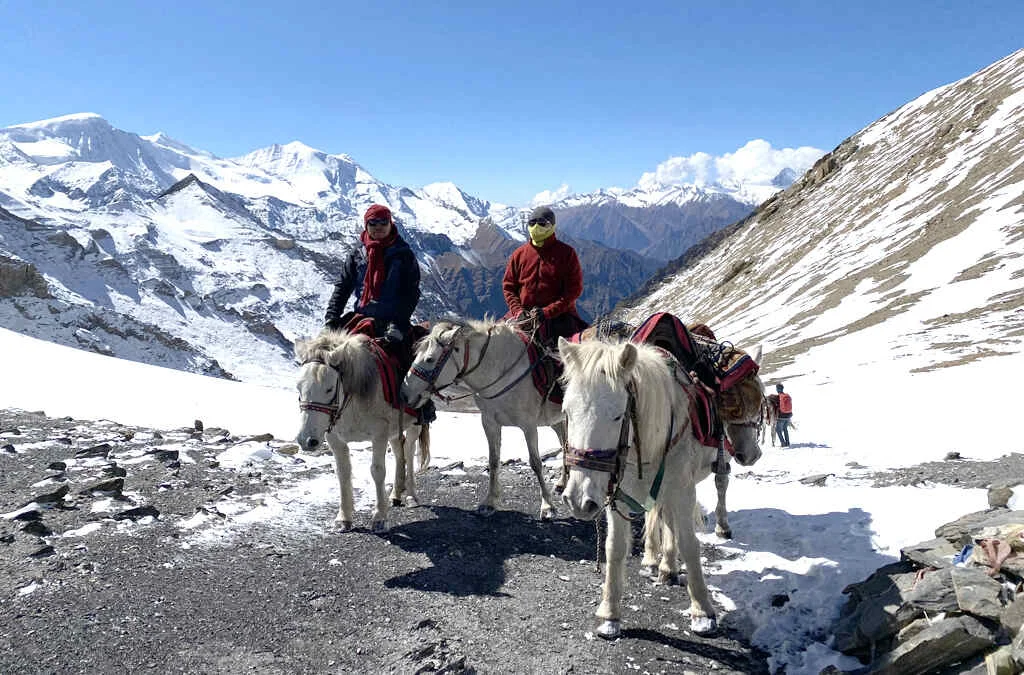




 Overviews
Overviews
 Trip Overview
Trip Overview
 Travel Itinerary
Travel Itinerary
 Cost Include
Cost Include
 Cost Exclude
Cost Exclude
 Fixed Departure
Fixed Departure
 Route Map
Route Map

 Freqeuntly Asked Questions
Freqeuntly Asked Questions
 Reviews And Rating
Reviews And Rating
